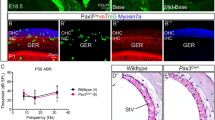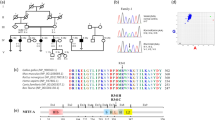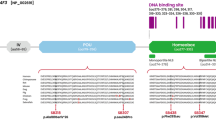Abstract
Waardenburg syndrome (WS) is a hereditary disorder that causes hypopigmentation and hearing impairment. Depending on additional symptoms, WS is classified into four types1: WS1, WS2, WS3 and WS4. Mutations in MITF (mi crophthalmia-associated t ranscription f actor) and PAX3, encoding transcription factors, are responsible for WS2 and WS1/WS3, respectively1. We have previously shown that MITF transactivates the gene for tyrosinase, a key enzyme for melanogenesis, and is critically involved in melanocyte differentiation2. Absence of melanocytes affects pigmentation in the skin, hair and eyes, and hearing function in the cochlea3. Therefore, hypopigmentation and hearing loss in WS2 are likely to be the results of an anomaly of melanocyte differentiation caused by MITF mutations4,5. However, the molecular mechanism by which PAX3 mutations cause the auditory-pigmentary symptoms in WS1/WS3 remains to be explained. Here we show that PAX3, a transcription factor with a paired domain and a homeodomain, transactivates the MITF promoter. We further show that PAX3 proteins associated with WS1 in either the paired domain or the homeodomain fail to recognize and transactivate the MITF promoter. These results provide evidence that PAX3 directly regulates MITF, and suggest that the failure of this regulation due to PAX3 mutations causes the auditory-pigmentary symptoms in at least some individuals with WS1.
This is a preview of subscription content, access via your institution
Access options
Subscribe to this journal
Receive 12 print issues and online access
$209.00 per year
only $17.42 per issue
Buy this article
- Purchase on Springer Link
- Instant access to full article PDF
Prices may be subject to local taxes which are calculated during checkout
Similar content being viewed by others
References
Read, A.P. & Newton, V.E. Waardenburg syndrome. J. Med. Genet. 34, 656–665 (1997).
Tachibana, M. et al. Ectopic expression of MITF, a gene for Waardenburg syndrome type 2, converts fibroblasts to cells with melanocyte characteristics. Nature Genet. 14, 50–54 (1996).
Tachibana, M. et al. Cochlear disorder associated with melanocyte anomaly in mice with a transgenic insertional mutation. Mol. Cell. Neurosci. 3, 433–445 (1992).
Tassabehji, M., Newton, V.E. & Read, A.P. Waardenburg syndrome type 2 caused by mutations in the human microphthalmia (MITF) gene. Nature Genet. 8, 251–255 (1994).
Nobukuni, Y., Watanabe, A., Takeda, K., Skarka, H. & Tachibana, M. Analyses of loss-of-function mutations of the MITF gene suggest that haploinsufficiency is a cause of Waardenburg syndrome type 2A. Am. J. Hum. Genet. 59, 76–83 (1996).
Latchman, D.S. Transcription-factor mutations and disease. N. Engl. J. Med. 334, 28–33 (1996).
Semenza, G.L. Transcriptional regulation of gene expression: mechanisms and pathophysiology. Hum. Mutat. 3, 180–199 (1994).
Tassabehji, M. et al. Waardenburg's syndrome patients have mutations in the human homologue of the Pax-3 paired box gene. Nature 355, 635–636 (1992).
Baldwin, C.T., Hoth, C.F., Amos, J.A., da-Silva, E.O. & Milunsky, A. An exonic mutation in the Hup2 paired domain gene causes Waardenburg's syndrome. Nature 355, 637–638 (1992).
Hoth, C.F. et al. Mutations in the paired domain of the human PAX3 gene cause Klein-Waardenburg syndrome (WS-III) as well as Waardenburg syndrome type I (WS-I). Am. J. Hum. Genet. 52, 455–462 (1993).
Lalwani, A.K. et al. Further elucidation of the genomic structure of PAX3, and identification of two different point mutations within the PAX3 homeobox that cause Waardenburg syndrome type I in two families. Am. J. Hum. Genet. 56, 75–83 (1995).
Tassabehji, M. et al. The mutational spectrum in Waardenburg syndrome. Hum. Mol. Genet. 4, 2131–2137 (1995).
Chalepakis, G., Goulding, M., Read, A., Strachan, T. & Gruss, P. Molecular basis of splotch and Waardenburg syndrome Pax-3 mutations. Proc. Natl. Acad. Sci. USA 91, 3685–3689 (1994).
Epstein, J.A., Shapiro, D.N., Chen, J., Lam, P.Y.P. & Maas, R.L. Pax3 modulates expression of the c-Met receptor during limb muscle development. Proc. Natl. Acad. Sci. USA 93, 4213–4218 (1996).
Opdecamp, K. et al. Melanocyte development in vivo and in neural crest cell cultures: crucial dependence on the Mitf basic-helix-loop-helix-zipper transcription factor. Development 124, 2377–2386 (1997).
Fuse, N., Yasumoto, K., Suzuki, H., Takahashi, K. & Shibahara, S. Identification of a melanocyte-type promoter of the microphthalmia-associated transcription factor gene. Biochem. Biophys. Res. Comm. 219, 702–707 (1996).
Chalepakis, G., Wijnholds, J. & Gruss, P. Pax-3-DNA interaction: flexibility in the DNA binding and induction of DNA conformational changes by paired domains. Nucleic Acids Res. 22, 3131–3137 (1994).
Guazzi, S. et al. The thyroid transcription factor-1 gene is a candidate target for regulation by Hox proteins. EMBO J. 13, 3339–3347 (1994).
Macina, R.A., Barr, F.G., Galili, N. & Riethman, H.C. Genomic organization of the human PAX3 gene: DNA sequence analysis of the region disrupted in alveolar rhabdomyosarcoma. Genomics 26, 1–8 (1995).
Schreiber, E., Matthias, P., Müller, M.M. & Schaffner, W. Rapid detection of octamer binding proteins with ‘mini-extracts’, prepared from a small number of cells. Nucleic Acids Res. 17, 6419 (1989).
Fredericks,W.J. et al. The PAX3-FKHR fusion protein created by the t(2;13) translocation in alveolar rhabdomyosarcomas is a more potent transcriptional activator than PAX3. Mol. Cell. Biol. 15, 1522–1535 (1995).
Jones, D.H. & Howard, B.H. A rapid method for the site-specific mutagenesis and directional subcloning by using the polymerase chain reaction to generate recombinant circles. BioTechniques 8, 178–183 (1990).
Kamachi, Y. & Kondoh, H. Overlapping positive and negative regulatory elements determine lens-specific activity of the δ1-crystallin enhancer. Mol. Cell. Biol. 13, 5206–5215 (1993).
Miki, T. et al. Development of a highly efficient expression cDNA cloning system: application to oncogene isolation. Proc. Natl. Acad. Sci. USA 88, 5167–5171 (1991).
Sublett, J.E., Jeon, I.-S. & Shapiro, D.N. The alveolar rhabdomyosarcoma PAX3/FKHR fusion protein is a transcriptional activator. Oncogene 11, 545–552 (1995).
Author information
Authors and Affiliations
Corresponding author
Rights and permissions
About this article
Cite this article
Watanabe, A., Takeda, K., Ploplis, B. et al. Epistatic relationship between Waardenburg Syndrome genes MITF and PAX3. Nat Genet 18, 283–286 (1998). https://doi.org/10.1038/ng0398-283
Received:
Accepted:
Issue Date:
DOI: https://doi.org/10.1038/ng0398-283
This article is cited by
-
Nerve-associated Schwann cell precursors contribute extracutaneous melanocytes to the heart, inner ear, supraorbital locations and brain meninges
Cellular and Molecular Life Sciences (2021)
-
Gene therapy development in hearing research in China
Gene Therapy (2020)
-
Differentiation of adipose-derived stem cells to functional CD105neg CD73low melanocyte precursors guided by defined culture condition
Stem Cell Research & Therapy (2019)
-
From neural crest cells to melanocytes: cellular plasticity during development and beyond
Cellular and Molecular Life Sciences (2019)
-
The regulatory mechanisms of NG2/CSPG4 expression
Cellular & Molecular Biology Letters (2017)



